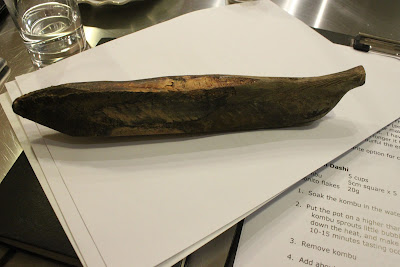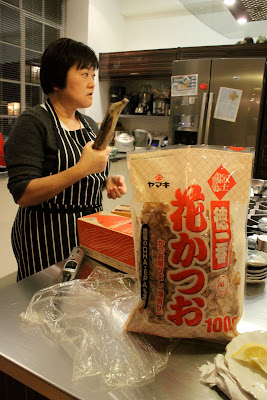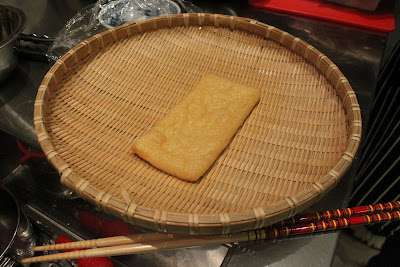I first met Hiromi at The Underground Farmer’s Market at my house. She had a stall that sold Japanese flavoured mixed nuts and approached the ‘foodie’ Dragon’s Den panel with her product. Since then her seasoned nuts have been picked up by Jo and Ben at The Deli Station and is now sold at Harvey Nichols and other high profile gourmet food outlets.
 |
| Kinomi Mixed Nuts |
Hiromi Stone is Japanese but brought up in the States so she speaks perfect English. She hosts regular Japanese cooking classes at her home in Kings Cross. Her goal is to show that there is more to Japanese cookery than sushi; this class concentrated on ‘Dashi’ which she describes as the soul of Japanese food. Although I’m an experienced cook, I learnt a great deal from this class.
First of all Hiromi talked about rice cookers (I’m a big fan) which the Japanese use in all sorts of ways, even to make cakes. I asked the difference between the different ‘soy’ sauces: ‘shoyu’ for instance is merely Japanese for ‘soy’, whereas ‘tamari’ sauce is thicker and is traditionally used with sashimi as it adheres to fish better. Light soy sauce is used for the colour plus it’s saltier. It’s worth spending extra on a decent Japanese soy sauce rather than cheap Chinese imitations.
To make a quick dashi you need water, kombu seaweed and Bonito flakes. Hiromi had a fantastic bonito shaver.
 |
Believe it or not this wooden object is actually bonito, a kind of tuna. Here it is smoked and dried and is an essential element in ‘dashi’. This piece of bonito is a few years old. Hiromi brought it back from Japan, saying “I love UK customs” meaning they’ll let anything in, compared to the US. Retro bonito shaver. |
 |
| The shavings go into a drawer at the bottom! I love it! |
 |
|
However most of us only have access to ready made dried bonito shavings, sold by the bag.
Most of the ingredients used in the class are available at Natural Natural, The Japan Centre or Rice Wine shop which delivers. Dashi is a stock but unlike western stock, you don’t boil it. It’s the basis of miso soup. Hiromi talked about the different kinds of miso: dark miso comes from Northern Japan; lighter miso from Western and Southern Japan; sweet miso from Kyoto. The rougher miso, with bits in, is called ‘country miso’. You can make your own miso from soybean, rice, barley and a kind of mould. It’s a fermented food, hence very ‘umami’, the fifth taste. The scientist who discovered ‘umami’ was Japanese, he used dashi as the basis for his studies.
Dark and light miso
Hiromi used these interesting aluminium cooking pots without handles. She says aluminium is not an issue in Japanese (the alzheimer’s scare). The saucer is for tasting. Hiromi says Japanese people normally taste food in a saucer not with a spoon.
The handle is completely separate like something one uses for camping.
A basic recipe for dashi (Hiromi also gives two more that are more complex and traditional):
1 litre + 1 cup of water
8cms square of Kombu
30g of Bonito flakes
Put Kombu and water into a pot on a low heat.
After approximately 10 minutes small bubbles form and the kombu begins to float. Remove kombu.
Bring to the boil then quickly take the pan off the heat and add 1/2 a cup of cold water to reduce the temperature.
Add the bonito flakes, add another 1/2 cup of water and let it steep for 30 seconds.
Strain through a sieve lined with a kitchen towel or muslin.
Use within 3 days.
Hiromi let us taste the kombu steeped water in the little saucers before she added the bonito. You could taste the iodine. We talked about the different kinds of seaweed, greatly used in Japanese cooking “slimy food is good for you”.
Kombu: must be cooked, sold in large sheets, used in dashi
Wakani: tender, must be soaked, a tiny pinch becomes huge, used in salads and soup
Hijiki: has to be cooked, otherwise it’s too chewy. You can put it in tofu balls.
Nori: the one you are most likely to know about: thin dried seaweed sheets, can be eaten raw but better toasted. Can be crumbled over salads, used to wrap sushi and onigiri.
Hiromi also told us that Japanese ginger pickles is normal ginger sliced thinly on a mandolin and dyed pink. But in Japan they use fresh young ginger ‘shin shoga’.
Inari tofu pocket
I believe tofu is unjustly maligned as boring, rather it is one of the great undiscovered foods in the west. There are different grades and types of tofu and ways of cooking it.
Inari tofu pockets: this are sweet fried tofu ‘envelopes’ that can be stuffed with rice. I totally love these and have been eating them by the packet. However Hiromi told me that they should first be rinsed with hot water to remove the grease, then squeezed dry.
Silken tofu: soft, usually it is drained, placed on the palm of the hand and cut gently into squares. Great in soups or as a vegan replacement in desserts. (I make a tofu chocolate mousse).
Firm tofu: tougher and easier to work with, great diced carefully into stir fries, or smoked. It’s very versatile.
When I was travelling in Tibet I had an amazing dish in Shigatse: firm tofu cut into rectangles and fried in red chilli sauce and garlic. It was so moreish I went back to the same lunch place every day to have it again. Today I made a smoked sesame tofu and roasted butternut squash with smoked paprika salad. Delicious! Always have a packet of tofu in the house.
Hiromi uses Californian sushi rice (approximately £25 for 15 kilos) rather than Italian as it’s better quality; authentic Japanese rice would cost £25 for only 5 kilos. She surprised the class by explaining that it’s better to buy ‘fresh’ or ‘new crop’ rice for dry rice can, yes, dry out!
We then learnt to make Onigiri which are rice balls, very popular in Japan for picnics and packed lunches.
Take freshly cooked rice and various fillings such as pickled plums ( I adore umeboshi plums), tuna, bonito flakes with soy sauce or pickles.
Wrap with nori, adding a dab of filling to the outside for identification purposes.
These were absolutely delicious and addictive. At the end we sat down and ate the food we had learnt to prepare.
To join Hiromi’s classes go here: or email her: cooking@hiromistone.com
|













Such an informative post – I am one of those people who peer at the Japanese foods in the supermarket, intrigued but bewildered!
I really like your posts, it's so interesting to read all this stuff about food and you sharing your experience. Must have been great cooking with a Japanese.
I love this post. I'm a massive fan of Japanese cuisine myself, been cooking a lot of Japanese food lately on my own food blog.
The only problem for me, as you've mentioned on your post, is the bonito flakes, they are always sold ready shaved in huge pack, more than what I normally need and recommended to be used within 7 days of opening 🙁
read your post with particular interest because just a few evenings before, we enjoyed a delicious japanese meal at our friend's house that featured bonito flakes:
http://fallenfromflavour.blogspot.com/2012/02/okonomiyaki-night.html
Feast of the world: I don't think you have to use them within 7 days. As Hiromi said she's had that tuna log for years. They often put use by dates on food packaging just to be on the safe side.
Lemon: thanks it was fantastic. I recommend her classes.
Sally: I just love foreign supermarkets
Fallen from flavour: your blog is very pretty! I'm going to have a go at those Japanese pancakes. I had one in a restaurant and wasn't too impressed, I'm sure I could do a better job.